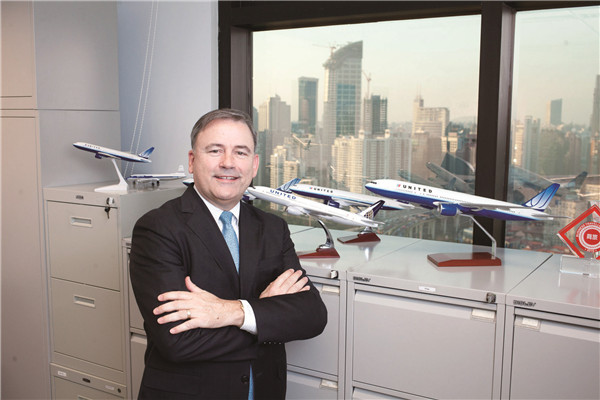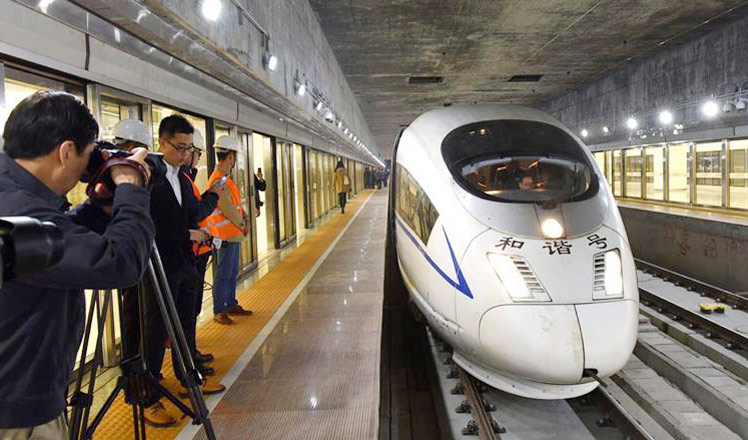A keen focus on the people
Updated: 2016-01-02 02:34
By Yu Ran in Shanghai(China Daily USA)
|
||||||||
 |
|
Walter Dias, managing director of United Airlines for Greater China and Korea, notes that the company is adopting a “China centric” approach to their marketing efforts in order to stand out from the competition. gao erqiang / china daily |
Walter Dias firmly believes that a company in the service industry will struggle to keep customers satisfied if its employees aren’t happy to begin with.
This has been his mantra for almost 29 years and it forms a vital part of his passion for dissecting problems in order to come up with new solutions to provide better customer service.
“When you are in the airline business, it is really all about the people — it is a customer service thing, you really have to approach things in a more personal way. This has been an important lesson I’ve learnt through the years,” said Dias, managing director of United Airlines for Greater China and Korea.
Some of the ways the company cares for their staff can be seen in policies such as the United Profit Sharing Plan, which stipulates that employees will receive a portion of the profits when the company earns more than $10 million in pre-tax earnings during a fiscal year. In 2014, a total of $235 million was distributed among eligible employees.
Other policies include monthly performance bonuses where employees can earn up to $125 a month based on the airline’s on-time performance statistics and customer satisfaction scores, as well as the United 100 Program, which allows employees to nominate their peers for an award that recognizes extraordinary customer service accomplishments or positive contributions to the company’s performance. The top 100 nominees of the year are awarded at a luncheon hosted by United’s CEO and senior management staff.
Currently based in Hong Kong but a frequent visitor to the mainland, Dias spent most of his career working for Continental Airlines, a major US airline that was founded in 1934 and headquartered in Houston, Texas.
In May 2010, the airline announced that it was making a merger of equals with UAL Corporation, the parent company of United Airlines, via a stock swap. Continental’s shares were acquired by UAL Corporation and the acquisition was completed in October 2010, at which time the holding company was renamed United Continental Holdings.
“I was very excited that Continental and United were merging — from a network perspective, it was like a marriage made in heaven. For us in Asia, we were able to combine the flights from the west and east coasts of the US to China and we were able to provide a larger variety of options for Chinese consumers to choose from,” he said.
Dias’ foray into Asia began over two decades ago, following his stint in the internal audit department of the company where he was constantly on the lookout for ways to improve customer service, cost savings and efficiency.
“This experience allowed me to peek into the different areas of the airline and, within a short time, helped me understand how they worked together to make a successful operation,” said Dias.
Besides being the first airline to fly the New York-Hong Kong route as well as cross the polar route, Continental was only the third US airline to bridge the distance between the US and China. In 2004, the airline had flights connecting New York to Beijing, marking its first step into the Chinese mainland.
Today, United is the largest airline in terms of passenger capacity for trips between the US and China, offering daily flights from Shanghai, Beijing and Hong Kong to American cities.
China has for the past 30 years been a key market for United Airlines and this looks to be even more evident now that the US ranks among one of the top tourist destinations for Chinese travelers, as revealed by recent market surveys.
Dias noted that the company is adopting a “China centric” approach to their marketing efforts in order to stand out from the competition, with some of the value added services being the inclusion of Chinese cuisines on flights and Mandarin language services.
“The number of Chinese customers are getting close to equaling the number of US customers,” said Dias.
“People in China today want a better travel experience. They are reducing the number of destinations during a trip and spending more time at each place, a stark contrast from a decade ago when they wanted to see as many places as possible in the shortest amount of time.”
Between 2010 and 2015, the total number of outbound Chinese tourists to the US increased from 800,000 to 2.1 million. The figures are expected to hit 6.6 million as early as 2021, making the Chinese market the biggest source of travelers for the US.
In order to stay current with the dynamic regional economies within China, United Airlines constantly monitors the regional markets in search of new business opportunities. In 2014, United Airlines opened its Chengdu-San Francisco route after having identified the Chinese city as being a hot spot for foreign investors, while a trial route connecting Xi’an and San Francisco will be available from May 10, 2016.
“United Airlines is the first to fly from a non-tier-one city so we are very excited to be the pioneer. Xi’an represents our next step forward,” said Dias.
Describing United as “a technology company with wings”, Dias added that the company was the first airline in the world to use electronic boarding passes and continues to invest in new technology such as a new enhanced website and mobile apps. The airline has also been making continuous investments in new aircrafts since the merger with Continental. United had placed a massive order of 65 Boeing 787 Dreamliners when the aircraft was first launched and there are currently 25 of them in United’s fleet.
With regard to the airline’s future plans, Dias is very confident that United will expand its network to serve more secondary cities in China.
“The future is looking very bright and we will always be on the lookout for ways to increase customer satisfaction and attract more Chinese consumers with our outstanding travel services,” said Dias.
- Top planner targets 40% cut in PM2.5 for Beijing-Tianjin-Hebei cluster
- Yearender: Predictions for 2016 through 20 questions
- Asia's largest underground railway station opens in Shenzhen
- Shanghai bans drug-using actors, drivers
- Clamping down to clean up the air
- Yearender: Ten most talked-about newsmakers in 2015
- Over 1 million refugees have fled to Europe by sea in 2015: UN
- Turbulence injures multiple Air Canada passengers, diverts flight
- NASA releases stunning images of our planet from space station
- US-led air strikes kill IS leaders linked to Paris attacks
- DPRK senior party official Kim Yang Gon killed in car accident
- Former Israeli PM Olmert's jail term cut, cleared of main charge

 Yearender: China's proposals on world's biggest issues
Yearender: China's proposals on world's biggest issues
 NASA reveals entire alphabet but F in satellite images
NASA reveals entire alphabet but F in satellite images
 Yearender: Five major sporting rivalries during 2015
Yearender: Five major sporting rivalries during 2015
 China counts down to the New Year
China counts down to the New Year
 Asia's largest underground railway station opens in Shenzhen
Asia's largest underground railway station opens in Shenzhen
 Yearender: Predictions for 2016 through 20 questions
Yearender: Predictions for 2016 through 20 questions
 World's first high-speed train line circling an island opens in Hainan
World's first high-speed train line circling an island opens in Hainan
 'Internet Plus' changes people's lifestyles in China
'Internet Plus' changes people's lifestyles in China
Most Viewed
Editor's Picks

|

|

|

|

|

|
Today's Top News
Shooting rampage at US social services agency leaves 14 dead
Chinese bargain hunters are changing the retail game
Chinese president arrives in Turkey for G20 summit
Islamic State claims responsibility for Paris attacks
Obama, Netanyahu at White House seek to mend US-Israel ties
China, not Canada, is top US trade partner
Tu first Chinese to win Nobel Prize in Medicine
Huntsman says Sino-US relationship needs common goals
US Weekly

|

|







